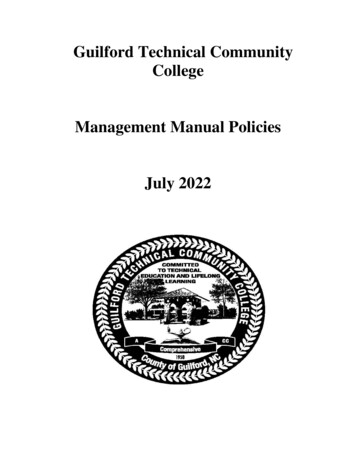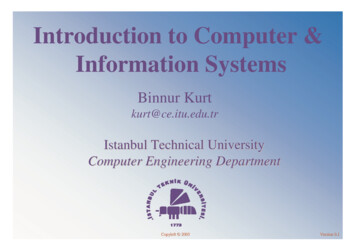
Transcription
CS6004 / CYBER FORENSICSUNIT IIIINTRODUCTION TO COMPUTER FORENSICSIntroduction to Traditional Computer Crime, Traditional problems associated withComputer Crime. Introduction to Identity Theft & Identity Fraud. Types of CFtechniques – Incident and incident response methodology – Forensic duplication andinvestigation. Preparation for IR: Creating response tool kit and IR team. – ForensicsTechnology and Systems – Understanding Computer Investigation - Data Acquisition.Part-A1.Define computer crime. Computer crime is any criminal offense, activity or issue that involvescomputers Computer misuse tends to fall into two categories. Computer is used to commit a crime Computer itself is a target of a crime. Computer is the victim. ComputerSecurity Incident. Computer Incident Response2. Define computer forensics. Computer Forensics involves the preservation, identification, extraction,documentation and interpretation of computer data [1] Computer Forensics is the application of science and engineering to the legalproblem of digital evidence. It is a synthesis of science and law. Computer forensics, still a rather new discipline in computer security, focuseson finding digital evidence after a computer security incident has occurred . The goal of computer forensics is to do a structured investigation and find outexactly what happened on a digital system, and who was responsible for it.3.List out the Traditional problems associated with Computer Crime.1. Physicality and Jurisdictional Concerns2. Perceived Insignificance, Stereotypes, and Incompetence3. Prosecutorial Reluctance4. Lack of Reporting5. Lack of Resources6. Jurisprudential Inconsistency7. Jurisprudential Inconsistency4.Define identify theft. The generic term identity theft has been utilized to describe any use of stolenpersonal information. However, such characterization fails to provide acomprehensive picture of the totality of possibilities surrounding that constructknown as identity.Prepared By: Mr X.MARTIN LOURDURAJ AP/CSE ,ST.ANNESCET1
CS6004 / CYBER FORENSICS5. Define Identity fraud. Identity fraud, which encompasses identity theft within its purview, may bedefined as the use of a vast array of illegal activities based on fraudulent use ofidentifying information of a real or fictitious person.6.List out the Typologies of Identity Theft/Frauda. Assumption of Identityb. Theft for Employment and/or Border Entryc. Criminal Record Identity Theft/Fraudd. Virtual Identity Theft/Fraude. Credit Identity Theft/Fraud7.List out the Physical Methods of Identity Thefta. Mail Theftb. Dumpster Divingc. Theft of Computersd. Bag Operationse. Child Identity Theftf. Insidersg. Fraudulent or Fictitious Companiesh. Card Skimming, ATM Manipulation, and Fraudulent Machines8.How to prepare a computer investigation.prepare a computer investigation Digital investigations fall into two categories:– Public-sector investigations– Private-sector investigations Public-sector investigations involve government agencies responsible forcriminal investigations and prosecution Fourth Amendment to the U.S. Constitution– Restrict government search and seizure9.What are the Steps for problem solvingSteps for problem solving– Make an initial assessment about the type of case you are investigating– Determine a preliminary design or approach to the case– Create a detailed checklist– Determine the resources you need– Obtain and copy an evidence drive– Identify the risks– Mitigate or minimize the risks– Test the design– Analyze and recover the digital evidencePrepared By: Mr X.MARTIN LOURDURAJ AP/CSE ,ST.ANNESCET2
CS6004 / CYBER FORENSICS– Investigate the data you recover– Complete the case report– Critique the case10.Write the steps for Planning Your Investigation A basic investigation plan should include the following activities:– Acquire the evidence– Complete an evidence form and establish a chain of custody– Transport the evidence to a computer forensics lab– Secure evidence in an approved secure container– Prepare your forensics workstation– Retrieve the evidence from the secure container– Make a forensic copy of the evidence– Return the evidence to the secure container– Process the copied evidence with computer forensics tools11.List out the forensics technology.1. Types of Military Computer Forensic Technology2. Types of Law Enforcement: Computer Forensic Technology3. Types of Business Computer Forensic Technology12.List out the forensics system. Internet security systems Intrusion detection systems Firewall security systems Storage area network security systems Network disaster recovery systems Public key infrastructure security systems Wireless network security systems Satellite encryption security systems Instant messaging (IM) security systems Net privacy systems Identity management security systems Identity theft prevention systems Biometric security systems Homeland security systems13.Draw the internet security hierarchy.14.Define Intrusion Detection.Prepared By: Mr X.MARTIN LOURDURAJ AP/CSE ,ST.ANNESCET3
CS6004 / CYBER FORENSICS Intrusion detection systems help computer systems prepare for and dealwith attacks. Monitoring and analysis of user and system activity Auditing of system configurations and vulnerabilities Assessing the integrity of critical system and data files Recognition of activity patterns reflecting known attacks Statistical analysis of abnormal activity patterns Operating system audit trail management, with recognition of useractivity reflecting policy violations15.write the benefits of firewalls.Benefits of Firewalls Protection from vulnerable services Controlled access to site systems Concentrated security Enhanced privacy Logging and statistics on network use and misuse Policy enforcementPart-B1. Explain in detail about the computer crime. Computer crime is any criminal offense, activity or issue that involvescomputers Computer misuse tends to fall into two categories. Computer is used to commit a crime Computer itself is a target of a crime. Computer is the victim. ComputerSecurity Incident. Computer Incident Response. Computer Forensics involves the preservation, identification, extraction,documentation and interpretation of computer data [1] Computer Forensics is the application of science and engineering to the legalproblem of digital evidence. It is a synthesis of science and law. Computer forensics, still a rather new discipline in computer security, focuseson finding digital evidence after a computer security incident has occurred . The goal of computer forensics is to do a structured investigation and find outexactly what happened on a digital system, and who was responsible for it.Introduction The introduction of the Internet has created unparalleled opportunities forcommerce, research, education, entertainment, and public discourse. A globalmarketplace has emerged, in which fresh ideas and increased appreciation formulticulturalism have flourished.Prepared By: Mr X.MARTIN LOURDURAJ AP/CSE ,ST.ANNESCET4
CS6004 / CYBER FORENSICS The introduction of computerized encyclopedias, international consortia,worldwide connectivity, and communications has greatly enhanced quality oflife for many individuals. Indeed, the Internet can be utilized as a window to the world, allowingindividuals to satiate their curiosity and develop global consciousness. It allowsindividuals to experience those things that they have only dreamed about. Interested parties can visit the Louvre, devouring priceless artifacts at theirleisure or take an African safari without the heat or mosquitoes. They can findanswers to the most complex legal or medical questions or search for their soulmates. They can download coupons for their favorite restaurants or search for recipesto their favorite dishes. In addition, individuals, corporations, public organizations, and institutions canmore effectively advertise their products or services, using graphicallyhighlighted information and providing links to supplemental information orsupport. In fact, computerized access to unprecedented information has cut acrosstraditional boundaries of communication.Cyberspace and Criminal Behavior Cyberspace may be defined as the indefinite place where individuals transactand communicate. It is the place between places. Telephonic conversations, occurring across time and space, were pre-dated bywire exchanges. However, the new medium known as the Internet hasmonumentally increased the physicality of the virtual world, outpaced only bythe exponential growth in the number of users. No other method of communication converges audio, video, and data entities soeffectively. Unlike traditional methods, the Internet combines mail, telephone, and massmedia. As stated previously, it exposes individuals to a myriad of new ideas andmay serve as a social gathering place, a library, or a place to be alone. In fact, the two created the Electronic Frontier Foundation (EFF) offering to―fund, conduct, and support legal efforts to demonstrate that the Secret Servicehas exercised prior restraint on publications, limited free speech, conductedimproper seizure of equipment and data, used undue force, and generallyPrepared By: Mr X.MARTIN LOURDURAJ AP/CSE ,ST.ANNESCET5
CS6004 / CYBER ,oppressiveandunconstitutional.‖ While early actions by the U.S. Secret Service may validate some of these earlyconcerns, the efforts of the EFF have often overlooked the negative potentiality ofthis global marketplace that has reunited a society that had increasingly removeditself through suburbanization. Just as the Industrial Revolution enhanced threatsto national security and created an environment conducive to street/predatorycrime through the concentration of the urban population, the Information orDigital Revolution has created a new forum for both terrorist activity and criminalbehavior. Indeed, this latest technological era has exacerbated the vulnerabilities ofgovernment institutions and personal residences alike. Critical infrastructures,increasingly characterized by tight couplings and interdependency of IT, emergencyservices, public utilities, banking sectors, food supplies, and transportationsystems, have resulted in an interconnectivity inconsistent with traditional securitystrategies. Such myopia has similarly impacted private citizens who have failed toemploy rudimentary measures of cyberprotection even as they add additionaldoorlocks and alarm systems to insulate themselves from physical attacks.Clarification of Terms Just as debates rage over the appropriate codification of crime committed viaelectronic means, controversy surrounds the actual semantics associated withthe phenomenon. For clarification purposes, then, it is necessary to define the historical usage ofterms associated with technological or electronic crimes. Computer crime hasbeen traditionally defined as any criminal act committed via computer.Computer-related crime has been defined as any criminal act in which acomputer is involved, even peripherally. Cybercrime has traditionally encompassed abuses and misuses of computersystems or computers connected to the Internet which result in direct and/orconcomitant losses. Finally, digital crime, a relatively new term, includes anycriminal activity which involves the unauthorized access, dissemination,manipulation, destruction, or corruption of electronically stored data. As datamay be accessed or stored in a variety of ways and in a variety of locations,digital crime may be characterized as any of the three depending on casecharacteristics.Prepared By: Mr X.MARTIN LOURDURAJ AP/CSE ,ST.ANNESCET6
CS6004 / CYBER FORENSICS While computer crime and computer related crime will be used interchangeablythroughout the text, cybercrime will only be used to describe that criminal activitywhich has been facilitated via the Internet. Just as confusion exists regarding the appropriate terminology for crimes involvingcomputers, the nomenclature of the science developed to investigate such activitylacks universality. For clarification purposes in this text, computer forensic science, computerforensics, and digital forensics may be defined as the methodological, scientific,and legally sound process of examining computer media and networks for theidentification, extraction, authentication, examination, interpretation, preservation,and analysis of evidence.2. Explain in detail about the Traditional problems associated with ComputerCrime.8. Physicality and Jurisdictional Concerns9. Perceived Insignificance, Stereotypes, and Incompetence10. Prosecutorial Reluctance11. Lack of Reporting12. Lack of Resources13. Jurisprudential Inconsistency14. Jurisprudential InconsistencyPhysicality and Jurisdictional Concerns The physical environment that breeds computer crime is far different fromtraditional venues. In fact, the intangible nature of computer interaction and subsequentcriminality poses significant questions for investigative agents. The lack of physical boundaries and the removal of traditional jurisdictionaldemarcations allow perpetrators to commit multinational crime with little fear(or potential) of judicial sanctions. For the first time, criminals can cross international boundaries without the useof passports or official documentation. Whereas traditional criminal activity required the physical presence of theperpetrators, cybercrime is facilitated by international connections that enableindividuals to commit criminal activity in England while sitting in their officesin Alabama. In addition, electronic crime does not require an extensive array ofequipment or tools.Perceived Insignificance, Stereotypes, and Incompetence Investigators and administrators have displayed great reluctance to pursuecomputer criminals.Prepared By: Mr X.MARTIN LOURDURAJ AP/CSE ,ST.ANNESCET7
CS6004 / CYBER FORENSICS A lack of knowledge coupled with general apathy toward cyber criminality hasresulted in an atmosphere of indifference. Many stereotype computer criminals as nonthreatening, socially challengedindividuals (i.e., nerds or geeks) and fail to see the insidious nature of computercrime; In addition, those administrators and investigators who grudgingly admit thepresence and danger of electronic crime tend to concentrate exclusively on childpornography, overlooking motivations and criminal behaviors apart from sexualgratification. Even in situations where law enforcement authorities recognize the insidiousnature of computer or cybercrime, many do not perceive themselves or others intheir department to be competent to investigate such criminal activity.Prosecutorial Reluctance As media focus has increasingly highlighted the dangers of cyberspace,including those involving cyber bullying and child exploitation, publicawareness has heightened an urgency to protect children’s virtualplaygrounds. In response, federal and state resources have often been allocated to fundspecialized units to investigate and prosecute those offenses which affect thesafety of American children. For example, the Federal Bureau of Investigation maintains a partnershipwith the Child Exploitation and Obscenity Section of the Department ofJustice. This organization is composed of attorneys and computer forensic specialistswho provide expertise to U.S. Attorney’s Offices on crimes against childrencases.Lack of Reporting The number of reported incidents handled by Carnegie-Mellon University’sComputer Emergency Response Team (CERT) has increased threefold, from24,097 in 2006 to 72,065 in 2008.13 In their annual survey, CSO Magazine (inconjunction with the U.S. Secret Service; CERT, and Deloitte) reported that 58percent of the organizations surveyed perceived themselves to be more preparedto prevent, detect, respond to, or recover from a cybercrime incident comparedto the previous year. However, only 56 percent of respondents actually had a plan for reporting andresponding to a crime.14 In 2011, it was reported that over 75 percent of allinsider intrusions were handled internally without notification of authorities. Underreporting on the part of businesses and corporations may be attributed toa variety of reasons, but perhaps the most common are exposure to financialPrepared By: Mr X.MARTIN LOURDURAJ AP/CSE ,ST.ANNESCET8
CS6004 / CYBER FORENSICSlosses, data breach liabilities, damage to brand, regulatory issues, and loss ofconsumer confidence. Contemporary society, characterized by increased reliance on paperlesstransactions, demands assurances that the company’s infrastructure isinvulnerable and that confidential information remains inviolate.Lack of Resources Computer intrusions have proven to be problematic within the corporate world,such institutions’ unwillingness or inability to effectively communicate withjudicial authorities has led to an increase in computer crime. Unfortunately, law enforcement and corporate entities desperately need tocooperate with one another. Unlike their civil service counterparts, the business communities have theresources (both financial and legal) necessary to effectively combat computercrimes. First, these companies, through their system administrators, have far moreleeway in monitoring communications and system activities, and they have theability to establish policies which enable wide-scale oversight.Jurisprudential Inconsistency Unfortunately, the Supreme Court has remained resolutely averse todeciding matters of law in the newly emerging sphere of cyberspace. They have virtually denied cert on every computer privacy case to whichindividuals have appealed and have refused to determine appropriatelevels of Fourth Amendment protections of individuals and computerequipment. This hesitation has become even more pronounced with the emergence ofwireless communications, social networking sites, and smart phones. As such, obvious demarcations of perception, application, andenforcement of computer crime laws vary widely across the country, anda standard of behavior in one jurisdiction may supersede or even negatelegal standards in another. Traditionally, trial and appellate courts evaluated the constitutionality ofcomputer crime statutes, searches, and investigations through the lensof the First and Fourth Amendment. Evaluating appropriate boundaries for free speech and establishingstandards of reasonableness have varied across state and federal rulings,and an inconsistent patchwork of guidelines has resulted.Prepared By: Mr X.MARTIN LOURDURAJ AP/CSE ,ST.ANNESCET9
CS6004 / CYBER FORENSICS3. Explain in detail about the Identify theft and identify fraud. The generic term identity theft has been utilized to describe any use of stolenpersonal information. However, such characterization fails to provide acomprehensive picture of the totality of possibilities surrounding that constructknown as identity. Identity fraud, which encompasses identity theft within its purview, may bedefined as the use of a vast array of illegal activities based on fraudulent use ofidentifying information of a real or fictitious person.Typologies of Identity Theft/Frauda. Assumption of Identityb. Theft for Employment and/or Border Entryc. Criminal Record Identity Theft/Fraudd. Virtual Identity Theft/Fraude. Credit Identity Theft/Frauda. Assumption of Identity This is the rarest form of identity theft/fraud and occurs when an individualsimply assumes the identity of his or her victim, including all aspects of thevictim’s lives. It must be noted that this type of activity is atypical as it is significantly moredifficult to accomplish. Even if a thief could identically duplicate the physical characteristics andappearance of his intended target, the likelihood of mastering personalhistories, intimate relationships, and communication nuances is extremelyremote. However, it is important to note that this type of identity fraud has occurredeven in cases where the plausibility of such assumption borders on theridiculous.b. Theft for Employment and/or Border Entry This type of identity theft/fraud is increasingly common due to the growth ofillegal immigration and alien smuggling. It involves the fraudulent use of stolenor fictitious personal information to obtain employment or to gain entry into theUnited States. The documents most frequently intercepted by officials included alienregistration cards, nonimmigrant visas, passports and citizenship documents,and border crossing cards. These documents were presented by aliens who werePrepared By: Mr X.MARTIN LOURDURAJ AP/CSE ,ST.ANNESCET10
CS6004 / CYBER FORENSICSattempting to enter the United States in search of employment or otherimmigration benefits, like naturalization or permanent residency status.Here are some recent examples of identity theft for employment: 2008—Agriprocessors, Inc.—CEO, company managers, and human resourceemployees were charged with multiple counts of federal immigration violations. Amongother charges, the meat processing company was charged with harboring illegal aliensfor profit, document fraud, bank fraud, and aggravated identity theft. 2009—George’s Processing, Inc.—Company paid nearly half a million dollars after136 illegal aliens were found working at the Missouri plant. ,includingelevensupervisors and one human resources manager, were arrested by federal authoritiesafter a ten-month investigation revealed charges relating to identity theft foremployment. The arrests in Greenville, South Carolina, followed earlier arrests ofnearly two dozen plant managers.Criminal Record Identity Theft/Fraud This type is often overlooked in discussions of identity theft, perhaps because itis not as common or because the immediate financial repercussions are notsignificant. It has been used historically by individuals attempting to evade capture orcriminal prosecution. Reverse criminal record identity theft occurs when a criminal uses a victim’sidentity not to engage in criminal activity but to seek gainful employment.Unfortunately, criminal record identity theft/fraud is especially insidious as itoften remains undiscovered until the victim is pulled over for a routine trafficviolation. Unlike other types of identity fraud, in this case many victims arehorrified to discover that they have been victimized by a friend or relative.d. Virtual Identity Theft/FraudVirtual Identity Theft/Fraud A relatively new phenomenon, virtual identity theft/fraud involves the use ofpersonal, professional, or other dimensions of identity toward the developmentof a fraudulent virtual personality. As in the previous types discussed, motivations range from the relativelyinnocuous to extreme malevolence.Prepared By: Mr X.MARTIN LOURDURAJ AP/CSE ,ST.ANNESCET11
CS6004 / CYBER FORENSICS ks,legaldocumentation, and biological characteristics, virtual identities are largelypersonally constructed. Indeed, many individuals develop a virtual identity which is antithetical to theirphysical one—making themselves taller, richer, younger, more charismatic, andso on. In other words, virtual identities are often far removed from reality. As such, they are inherently less veracious and less trustworthy. They are oftenused for online dating, role-playing, and accessing deviant sites or locationscontaining questionable content. Although many individuals create virtual identities to explore forbidden areas orsatisfy their curiosity behind a veil of anonymity, most do not cross the linebetween the legal and the illegal worlds.Credit Identity Theft/Fraud It may be defined as the use of stolen personal and financial information tofacilitate the creation of fraudulent accounts. This definition, specific by design, requires the affirmative act of securingadditional credit. It does not include traditional activities like the illegal use of a stolen creditcard, as that activity is more appropriately situated under statutes concerningcredit card fraud. It is also not defined under identity theft, as the primary incentive is instantgratification. As credit cards are treated as cash by consumers and merchants alike, the useof a stolen one may be likened to purse snatching or pick-pocketing withoutphysical contact.Physical Methods of Identity Thefta. Mail Theftb. Dumpster Divingc. Theft of Computersd. Bag Operationse. Child Identity Theftf. Insidersg. Fraudulent or Fictitious CompaniesPrepared By: Mr X.MARTIN LOURDURAJ AP/CSE ,ST.ANNESCET12
CS6004 / CYBER FORENSICSh. Card Skimming, ATM Manipulation, and Fraudulent Machinesa. Mail Theft Although it is hard to identify which method of identity theft/fraud is mostcommonly employed, the theft of information from physical mailboxes iscertainly one of the most common. ndfinancialinformation are deposited in unlocked containers on the side of the road until itis retrieved. Oftentimes, such retrieval is conducted by someone other than the intendedrecipient and is used to generate illicit profit or to facilitate criminal activities.Physical mailboxes can contain a plethora of valuable information. Even as the government cautions citizens to take measures to protect theirpersonal and financial information, they themselves are delivering governmentidentification documents through U.S. Mail. Many times, they even mail breederdocuments.Dumpster Diving As the name implies, dumpster diving is the practice of sifting throughcommercial or residential trash or waste for information deemed valuable. Suchinformation ranges widely, but may include account numbers, social security ortax payer identification numbers, and passwords. It may be located on discarded computer media or in paper form, and may behoused in personnel records, accounting spreadsheets, receipts, invoices, or thelike.Prepared By: Mr X.MARTIN LOURDURAJ AP/CSE ,ST.ANNESCET13
CS6004 / CYBER FORENSICS Fortunately, both consumers and businesses have increasingly taken measuresto prevent the misuse of discarded information. Many now employ papershredders and disk-wiping software. Diving for information has been practiced by criminals and law enforcementalike. Early hackers found the trash to be especially helpful toward theirexploitation of computer vulnerabilities. Passwords, computer systems, andsoftware could be located there.Theft of Computers Physical theft of computers is among the most common techniques employed byidentity thieves, as it alleviates the need to analyze and organize voluminouspaper documents. As the majority of individuals necessarily store personal information on theircomputer, identity fraudsters are all but guaranteed a score. Even those individuals without technical expertise recognize that the computeras a warehouse of information has significant value on the black market, even ifthey themselves are incapable of retrieving the data. Areas vulnerable to such activity are limited only by the criminal mind.Bag Operations Another tactic historically utilized by intelligence agents which is currently usedby identity thieves and fraudsters is known as a ―bag operation,‖ and it involvesthe surreptitious entry into hotel rooms to steal, photograph, or photocopydocuments; steal or copy magnetic media; or download information from laptopcomputers. Almost routine in many countries, bag operations are typically conducted bythe host government’s security or intelligence services, frequently with thecooperation of the hotel staff. They are most often committed when guests leavetheir room.Child Identity Theft Increasingly, law enforcement authorities are reporting startling numbers ofparents stealing their children’s identities. According to the Federal TradeCommission, more than 140,000 children were victims of identity theft in2011.28 This represented a marked increase in numbers released by the samegroup in 2003.Prepared By: Mr X.MARTIN LOURDURAJ AP/CSE ,ST.ANNESCET14
CS6004 / CYBER FORENSICS Unfortunately, this type of identity theft or fraud is especially difficult to recognizeand prosecute. The primary problem, of course, is the delayed identification of the victimization, ascredit reports are usually not generated until the first application for credit, whichusually occurs after the individual reaches the age of 18. Second, the theft itself is not characterized as either child abuse or exploitation, sothe primary investigative agency for childrenInsiders Many authorities suggest that corporate and government insiders pose thegreatest risk to identity theft. As in other areas of computer crime, motivationsvary and the facilitation of fraud is not always intentional. In fact, careless employees account for a large amount of the identity theft inthe United States. Such negligence has been committed by both individualemployees and corporate divisions. In 2005, for example, Bank of America reported that the personal information of1.2 million U.S. government employees, including U.S. senators, had beencompromised when tapes were lost during shipment. In the same year,CitiGroup reported that UPS had lost the personal financial information ofnearly 4 million Citigroup customers.Fraudulent or Fictitious Companies Recently, a more sophisticated method of identity theft/fraud involves thecreation of shell companies. Almost always conducted by an organized ring of criminals, fake companies areestablished which are engaged in the processing or collection of personalfinancial information. These fictitious businesses range from debt collection to insurance agents. In ahighly visible case, over 145,000 consumers were put at risk by Choice point,an Atlanta-based company, which is one of the largest data aggregators andresellers in the country. Among other things, it compiles, stores, and sells information on the vastma
1.Define computer crime. Computer crime is any criminal offense, activity or issue that involves computers Computer misuse tends to fall into two categories. Computer is used to commit a crime Computer itself is a target of a crime. Computer is the victim. Computer Security Incident. Computer Incident Response 2. Define computer forensics.










